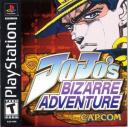Lost Classics: Jojo’s Bizarre Adventure (Arcade, Playstation, Dreamcast)
by William Talley, filed in Games, Lost Classics, Reviews on Feb.10, 2008
 Although it’s all but unknown over here, Hirohiko Araki’s manga Jojo’s Bizarre Adventure has enjoyed a sizable following in its native Japan. A bizarre mash up of vampires, martial artists, fortune tellers, superheroes, and gangsters, Jojo is a story about the trials and tribulations of the Joestar family. A major focus of the series are the stands, psychic entities which grant their users powers. Much of the series has been inspired by music, as it features several characters who have been named after songs, rappers, and rock bands. The series has been divided into 6 arcs, each taking place in a different time period and centered around a different main character. Capcom produced a series of games based on the third story arc, in which Jotaro Joestar, his grandfather, and their allies travel to Egypt to defeat a vampire in order to save Jotaro’s mother from her own stand (don’t ask). Although they are fighting games, they are as far removed from Street Fighter as they get. The first game, Jojo’s Venture, was released in the arcades in 1998 and was bought to the PS1 and Dreamcast with exclusive features. In typical Capcom fashion, Jojo’s Venture received a championship edition-style update complete with new characters and features known as Heritage for the Future. A third game was released in Japan for the PS2, but never made it over here.
Although it’s all but unknown over here, Hirohiko Araki’s manga Jojo’s Bizarre Adventure has enjoyed a sizable following in its native Japan. A bizarre mash up of vampires, martial artists, fortune tellers, superheroes, and gangsters, Jojo is a story about the trials and tribulations of the Joestar family. A major focus of the series are the stands, psychic entities which grant their users powers. Much of the series has been inspired by music, as it features several characters who have been named after songs, rappers, and rock bands. The series has been divided into 6 arcs, each taking place in a different time period and centered around a different main character. Capcom produced a series of games based on the third story arc, in which Jotaro Joestar, his grandfather, and their allies travel to Egypt to defeat a vampire in order to save Jotaro’s mother from her own stand (don’t ask). Although they are fighting games, they are as far removed from Street Fighter as they get. The first game, Jojo’s Venture, was released in the arcades in 1998 and was bought to the PS1 and Dreamcast with exclusive features. In typical Capcom fashion, Jojo’s Venture received a championship edition-style update complete with new characters and features known as Heritage for the Future. A third game was released in Japan for the PS2, but never made it over here.
This was the sixth and last game made with Capcom’s CPS3 board (seen in other games such as Red Earth and Street Fighter 3). Instead of the usual Capcom 6 button scheme, the game uses a simplified 4 button scheme. Three buttons are used for light, medium, and strong attacks, and the fourth button is used to activate the character’s stand power. The stands are kinda like a cross between Final Fantasy guardian forces and the dark force mode from Darkstalkers 3. It changes up a character’s movelist, increases their strength and defense, and adds new powers. However, not all characters work this way. Some characters, such as Holhorse and Chaka, wield their stands as weapons. Really, this makes it that the gameplay is dependent on each character. This tends to make gameplay unbalanced, but it is different from what Capcom veterans are used to. Characters you can choose from include, but aren’t limited to, a belly dancer, a cowboy with a gun stuck in his hand, an Indiana Jones-type character who wields an electric octopus, a dog, a killer bird, and a guy with strange hair who transforms his opponents into kids (by the way, if this attack is used on the Indiana Jones looking fellow, he’ll transform into a teenage version of himself). I only wish I could make up stuff like this even if I tried.
The Playstation version includes 6 characters exclusive to the arcade version. It also includes a Super Story Mode, which includes minigames that re-enact key battles from series three. The Dreamcast version doesn’t include this mode, but it does include the extra characters from the PS version, as well as both Jojo’s Venture and Heritage for the future. There are also a number of unlockable characters and gameplay modes. Although more serious fighting connoisseurs will be put off by this game’s lack of balance, fans of the manga will no doubt enjoy this game. People who are unfamiliar with the series will find themselves scratching their heads, but they will do so while they enjoy the game’s off the wall action. The industry needs more anime and manga inspired games this unique. I wonder what Mr. Araki was using when he came up with this stuff, and more importantly, where I can obtain some of it.


 PS3
PS3
 Famicom Dojo
Famicom Dojo KEEP PLAYING
KEEP PLAYING KEEP PLAYING: Rewind
KEEP PLAYING: Rewind Powet Toys
Powet Toys Powetcast
Powetcast Hitchhiker's Guide POWETcast
Hitchhiker's Guide POWETcast














